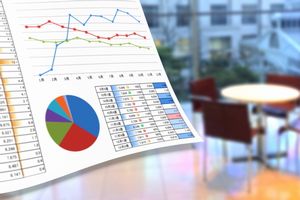The income and expenditure of first half of this year of Triton was announced. According to the article of Shipping Guide dated August 7 (Tue), the gross earnings of first half (from January to June) was 644,900,000 dollars (17.8% increase from the year before). The operating income was 367,400,000 dollars (55.8% increase from the year before). Net income was the black of 189,600,000 dollars (124.9% increase). They have recorded on average, 98.8% of the utilization of their own fleet. They will consider that lease and container sale are steady and the container demand will continue in future. We cannot but be surprised at the earning capacity. Let’s watch their operating profit on sales. The number is an amazing figure of 56.97%. They do not usually have any problem if they record 1-3% normally. They rank beside a listed company if they exceed 5%. Their profit made it one digit different. They gain on a lease and gain on the sale of an old container of more than 10 years. The expense container leasing company bear is only container purchase price and personnel expenses of operating containers (fixed costs). If a container is not returned, container management fee (storage, Lift on/off charge, repair charges) does not cost them at all. 98.8% of operation ratio prove it.
 In July, 2016, Triton and TAL merged aiming at the synergy by the scale. They changed into No.1 largest leasing company in the world with 5 million TEU. Their merger seems to be going well because their management policy is not big different like birds of a feather. Their current number of own containers expanded to a scale of 6 million TEU. Other leasing companies had similar movement afterwards. Textainer, No. 2 largest in the world has not felt down under the influence of large recovering cost from bankruptcy of Hanjin Shipping. Seaco of world No. 3 largest leasing company could not afford to do anything because their parent company, HNA has been suffered from a debt of 12 trillion yen and selling their subsidiary one by one for survival. There will not be the merger drama of the container lease company for the scale expansion for a while. It is the present conditions that other leasing companies don’t have any depot stock and have kept high utilization. In this sense, I think there is room for leasing company to grow more. In addition, it would be thought that a story of the mega-merger is jumping in someday.
In July, 2016, Triton and TAL merged aiming at the synergy by the scale. They changed into No.1 largest leasing company in the world with 5 million TEU. Their merger seems to be going well because their management policy is not big different like birds of a feather. Their current number of own containers expanded to a scale of 6 million TEU. Other leasing companies had similar movement afterwards. Textainer, No. 2 largest in the world has not felt down under the influence of large recovering cost from bankruptcy of Hanjin Shipping. Seaco of world No. 3 largest leasing company could not afford to do anything because their parent company, HNA has been suffered from a debt of 12 trillion yen and selling their subsidiary one by one for survival. There will not be the merger drama of the container lease company for the scale expansion for a while. It is the present conditions that other leasing companies don’t have any depot stock and have kept high utilization. In this sense, I think there is room for leasing company to grow more. In addition, it would be thought that a story of the mega-merger is jumping in someday.
On the other hand, the rumor of the merger of CMA CGM and Hapag-Lloyd is given in the shipping circle. I wonder how far the story make a jump like this. The scale expansion is one of the big pillars of the survivor strategy for a shipping company. Judging from the present conditions of the Antitrust Law, the possibility of this merger is thought not to be simple, but 2 companies’ share (11% for CMACGM, 7.3% for Hapag-Lloyd totals 18.3%) could not defeat Maersk’s share (18.7%) who is proud of No.1 share in the world. Since a giant called Maersk already exists, the merger takes on reality. If the merger is realized whom do the remaining of The Alliance, ONE and Yang Ming make Alliance with?
 The United States exercises 25% of additional duties to import goods of 279 items worthy of 16 billion dollars from China as second sanction duty effective on August 23. China will take the retaliation opposition measures, too. Shipping line would considerably encounter difficulty in the year of 2018 and their income and expenditure would be break-even or a deficit even if they should have tried to cut various costs such as substitute with the mega containerships, reduction of number of operating ships and slow speed navigation of the containerships, based on increase of fuel costs by the crude oil rise in price and the demand of low-sulfur fuel use carried out in January, 2020 while China and USA trade war has been escalating and under soundness of the recovery of at least Europe and America economy.
The United States exercises 25% of additional duties to import goods of 279 items worthy of 16 billion dollars from China as second sanction duty effective on August 23. China will take the retaliation opposition measures, too. Shipping line would considerably encounter difficulty in the year of 2018 and their income and expenditure would be break-even or a deficit even if they should have tried to cut various costs such as substitute with the mega containerships, reduction of number of operating ships and slow speed navigation of the containerships, based on increase of fuel costs by the crude oil rise in price and the demand of low-sulfur fuel use carried out in January, 2020 while China and USA trade war has been escalating and under soundness of the recovery of at least Europe and America economy.
On July 20, container maker of world No. 2, Singamas, listed in Hong Kong stock market announced that they became in the red in the first half of this year (from January to June). The big factor would attribute to the rise in price of steel materials. Though they raised $ 6.6 million net income the year before last, they anticipate a loss for this year by depreciation of Chinese yuan against US dollar and the competition with the domestic makers. On the other hand, Singamas sells a subsidiary in Huizhou of China, Hui Zhou Pacific Container Company (it produces Dry container of 20f, 40f, 45f and 53f) to Huizhou Shunjingyuan Industrial Company with RMB735 million (US $ 111 million).Its procedure will finish at the end of this year. Their production line is full up to the end of August. However, uneasiness increase how long the new container order may be continued under the effect of the development of China and USA trade war. Singamas is an affiliates of Pacific International Lines who registers in Singapore.
The current new container price is $ 2,200 per 20f. The new container factory stock is 913,500 TEU in total (880,000TEU for Dry and 33,500 TEU for Reefer) at the end of July.
The shipping company has done nothing but competing in the freight rate and after that restoring it as usual and the container maker has been fluctuating between hopes and fears for the price of container material particularly steel price and trying to fill the production lines with an order under competition with other makers. On the other hand, the container lease company does nothing after having supplied it once by a long-term lease. If the long term lease comes to an end the simplest thing is to get a shipping line to re-use them by the drastic lease rate down which they could not ignore. It shows an aspect of the winner-take-all of the leasing company.